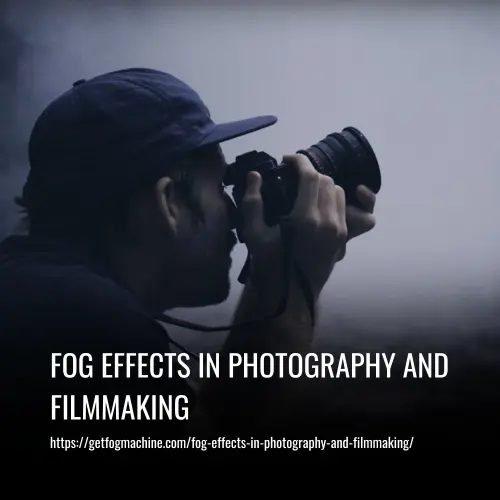How to Fix a Fog Machine: Troubleshooting Guide
This post contains affiliate links. As an Amazon Associate, we earn from qualifying purchases.
Fog machines are popular tools used in a variety of settings, from theatrical performances to parties and events. However, like any other piece of equipment, fog machines can experience issues over time. Whether it’s a decrease in fog output, a clogged nozzle, or a malfunctioning pump, these problems can be frustrating to deal with.
In this article, we will provide you with a comprehensive guide on how to fix a fog machine, addressing common issues that fog machine operators may encounter. From basic troubleshooting steps to more advanced solutions, we will cover it all.
By following our instructions, you’ll be able to get your fog machine up and running smoothly again, saving you time and money. So let’s dive in and solve those fog machine problems once and for all!

How to Fix a Fog Machine: A Step-by-Step Guide
Fog machines are a popular tool in creating atmospheric effects for parties, events, or Halloween decorations. However, like any electrical device, they can encounter issues. Here we will walk you through the steps to fix a clogged fog machine and ensure proper functioning.
Step 1: Safety first
Always unplug the fog machine from the power source before attempting any repairs or maintenance. This reduces the risk of electric shock.
Step 2: Determine the problem
If the fog machine is not producing smoke, it may be clogged. Unscrew the heating element and the liquid pump from the frame to access the inner components.
Step 3: Clear the clog
Using distilled water or fog machine cleaner, flush the pump and heating element. Alternatively, you can use a mixture of white vinegar and water to dissolve any built-up residue. Let the cleaning solution sit for a couple of minutes before blowing it out with compressed air.
Step 4: Check the pump
Ensure that the pump motor is functioning properly. If the pump is dead or faulty, it may need to be replaced with a new one. Look for replacement pumps specifically designed for fog machines.
Step 5: Check the fluid supply
Inspect the fog juice tank and ensure it is adequately filled. If the fog machine still doesn’t produce smoke, check the fluid supply pipe for any blockages. Clear any obstructions to allow uninterrupted flow.
Step 6: Reassemble and test
Once you have cleaned all the components, carefully reassemble the fog machine. Make sure to use insulation wool to prevent overheating and to minimize fire risks. Plug the machine back into the power source and test it to ensure proper fog output.
Regular maintenance is essential to keep your fog machine in good working condition. Clean the fog machine regularly, especially the fog juice tank, output nozzle, and heater blocks. Use fog machine cleaners or a mixture of distilled water and white vinegar for cleaning.
Perform regular checks on the machine’s components, such as the heater core and heat fuse, to catch any potential issues before they escalate.
Fixing the Individual Components of a Fog Machine
1. How To Fix The Fog Machine Heater
If the heater block is clogged, the fog machine will pump, but the output will be low. It is usually clogged with mineral deposits which are byproducts of contaminants in fog fluid. If you can observe these sediments, flush out the heater block with fog machine cleaner liquid or distilled white vinegar.
Keep in mind that you will have to pump fog fluid through the system to rinse it afterward.
In some instances, the fog fluid does not get to the heater due to clogs in the pump or the heater’s line. If it is heating up, but it’s dry, the problem is further along in the machine.
This is one of the circumstances where your heater will be producing hot air instead of fog. It is unhealthy for your machine as overheating may cause the heating element to crack.
Once the heating element is damaged, the only remedy is to get a new heater. The cost of installing one often surpasses the price of the entire fog machine; it becomes more economical to get a new fog machine.
The heating system sometimes fails due to external factors. It may not be getting power from the power source. Without heat, the fog machine is useless because fog production is impossible. It is this heat that even triggers the pump that pushes forth the fog fluid.
Test its leads to ascertain whether it is receiving any power in the first place. Find out where the circuit is breaking if no power is coming to it.
Occasionally the fog machine will churn out hot fog fluid instead of fog. This means the fluid is being introduced into the heater before the temperature is high enough to vaporize the fog solution before it is released from the fog machine.
This is not a problem with the heater but a thermocouple further down the line tasked with checking the temperature.
2. How To Fix The Fog Machine Thermocouple
This very crucial component is the sensor that decides when the heater is hot enough to vaporize the fog fluid into the fog and then powers the pump to push the fluid to the heater. It acts as a circuit breaker for both components, and when it fails, the entire fog machine fails.
If it breaks the connection with the heater, the fog machine can’t warm up, and if it can’t power up the pump, there is no fog juice to be vaporized. If the fog machine is spewing liquid fog juice, you will need to adjust or recalibrate this thermostat, so it engages the pump at a higher temperature.
If it is busted, you will notice there is power coming to it, but none leaving either to the heater or the pump. You can always replace it with another of a similar rating, which you will then calibrate to the same temperature.
3. How To Fix The Fog Machine Pump
This is another critical component responsible for pushing the fog juice from its tank to the heater and out of the fog machine when the temperature is right.
It is exposed to external dirt from the fluid tank as it is the immediate next stage the fog fluid passes through in the fog machine.
Due to this, it also clogs from time to time. Most of the clogging is removable by flushing the fog machine with a cleaning agent. Others are so stubborn that they block even the cleaning agent from passing through and require the dismantling of the pump.
Dismantling a pump is an intricate process, and once again, we recommend you seek the services of an expert if unsure or replace the entire pump. If you dismantle it, take the opportunity to give it a thorough wash, scraping off all visible deposits.
Disconnect it from the line transmitting fog fluid to the heater and the fluid reservoir and connect it directly to a power source to observe its behavior.
4. How To Fix The Electric Panel
Conduct a visual survey and use a voltmeter to test whether all fuses and relays are working. Modern fog machines have been designed to self-preserve, and you will blow a fair share of fuses if you over-exert them.
Muffling Excess Noise
Some fog machines with a high wattage rating are designed to produce stronger and faster fog jets that can cover large output distances. To successfully achieve this, the vapor comes out of the fog machine with tremendous force. This creates a prominent hissing sound that can be a huge distraction from the event itself.
It is important to figure out how to silence the machine if you own one of these because they are just meant to complement the setup, not be the centerpiece.
- One option is to move the fog machine further away from the heart of the action, so the noise is more removed from the scene. Doing this, however, interferes with its output distance, and a lot of the fog will go to waste. There is a limit to far you can go with this plan.
- Alternatively, you can raise the levels of other sound effects to the extent that the hiss of the fog machine is drowned.
- You can also form a sound barrier by placing other decorative material in front of the fog machine, covering it with a box, leaving only the nozzle area open, or building a housing structure in which you will place it during events. Take care that nothing touches the nozzle as it gets very hot when the fog machine is working. It is a potential fire hazard.
Other fog machines have very loud pumps. You can open them up and wrap the noisy fog machine pump with some form of insulation like fiberglass. However, this is a sensitive procedure, and you might want to check the terms of your warranty before choosing this path.
Consult the manufacturer if in doubt and ask for their recommended solution and whether it is normal behavior.
Tips For Preventing Future Damages
It’s usually a lot easier to take good care of your fog smoke machine than it is to do an extensive repair on your machine. Proper maintenance will keep it in great condition and will ensure good functionality for longer. Here are a few great tips that will keep your machine from troubleshooting.
1. Invest in a High-Quality Smoke Machine
At the end of the day, you get what you paid for. A high capacity fog machine with a high wattage rating – like a 500w smoke machine, a large fluid tank is necessary to achieve a greater output distance with more fog intensity. Its cost of acquisition will be relatively higher.
A smaller fog machine will have its limitations, and you should learn to operate within these limitations to avoid fixing your fog machine after every gig. The extra wear and tear will affect the service life of your machine, drastically reducing the value for money.
Some fog machines have small wattages but are packed with additional bells and whistles that can significantly raise their purchase cost, but their value addition is priceless. They come equipped with energy-saving technology, which allows them to provide longer service. Take a look at the example below.
2. Carefully Handle and Store Your Device
Storage and handling of the fog machine also play a big role in determining how often it will need repairs. This influences how much dirt it will encounter, the possibility of getting knocked around, and accumulating minor damages.
3. Avoid Spills
Be careful when adding liquids or fog machine fluid to your device. Spills can make your machine dirty and will create buildup on the device. Too much fog machine fluid buildup can result in a clog. Any accidents that do happen should be cleared up immediately.
4. Quality Products
Bad fog juice can decrease your pump output and can eventually damage the machine. It’s always best to fill your fog juice tank with quality juice.
5. Avoid Overuse
Fog machines with a small motor like a 400-Watt smoke machine, can’t run nonstop for as long as a device that has a large motor or industrial built-in unit. Small machines require regular time-outs to keep them from overheating.
Lots of modern devices come with an auto-off feature to help protect the machine but you should still keep an eye on your usage. Consider a wired remote control unit so you can remotely control the machine and turn it off regularly.
FAQs
If your fog machine is not working, there could be several reasons. One common issue is a clogged hose that brings fog juice into the machine. Another possibility is a problem with the power source or a blown fuse. Additionally, it could be an issue with the pump motor or a faulty remote control.
To get your fog machine to work, start by checking the power source and ensuring it is properly connected. Make sure the fog juice tank is filled with the correct fogger fluid. Check for any clogs in the hose or the output nozzle and clean them if necessary. Also, ensure that the pump button or switch is functioning properly. If these steps don’t resolve the issue, consider contacting the manufacturer or a professional for further assistance.
To unclog a fog machine, you can try running a mixture of 50% white vinegar and 50% distilled water through the machine’s fog juice tank. This can help break down any built-up deposits and unclog the lines. Run several cycles of this mixture until the clog is cleared. Additionally, regularly cleaning and maintaining your fog machine can prevent clogs and ensure optimal performance.
If your fog machine is spitting out water instead of producing fog, it could be due to several reasons. One possibility is that the fog juice being used is of poor quality or not compatible with the machine. Another reason could be a clogged heater block or heat exchanger. It’s important to use high-quality fog juice and regularly clean and maintain your machine to prevent these issues.
The lifespan of a fog machine can vary depending on various factors such as its quality, usage frequency, and proper maintenance. Generally, a well-maintained fog machine can last for several years. However, cheaper fog machines may have a shorter lifespan and may require more frequent repairs or replacements.
No, fog machines cannot run on water alone. Fog machines require a specialized fog juice or fog fluid to produce the desired fog effect. Using water alone may damage the machine and result in inadequate or ineffective fog output. Always use the recommended fog juice for your specific fog machine model.
Conclusion
In conclusion, fixing a fog machine is not as difficult as it may seem. By following the steps mentioned in this article, you can troubleshoot and repair common issues yourself, saving time and money. Remember to start with simple solutions like checking the power source and using proper fog juice. If the fog machine is clogged, clean the heater blocks and pump motor using a vinegar mixture. If necessary, consider replacing the pump or fog juice tank.
Regular maintenance, such as cleaning the heat exchanger and checking the heat fuse, can help prevent future problems. Lastly, always refer to the manufacturer’s instructions and seek professional help if you are unsure. With these tips, you can enjoy a reliable and high-performing fog machine for your events or productions.






